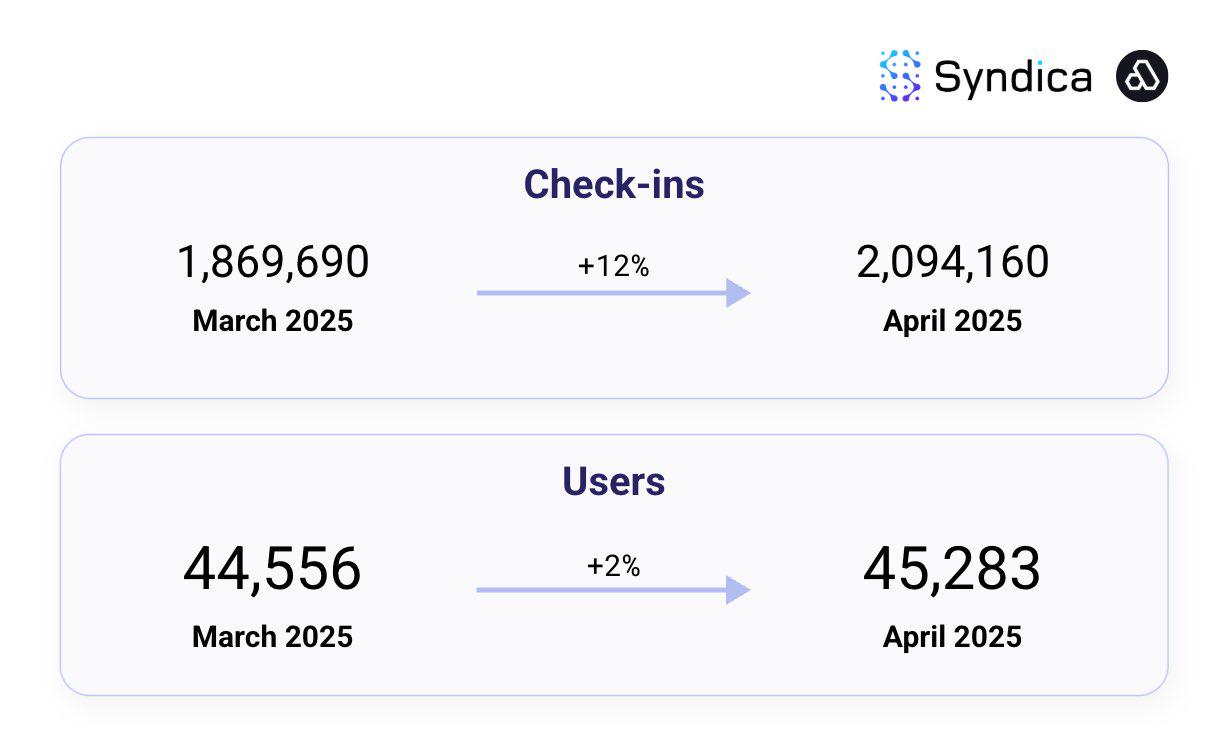Original author: Syndica
Original translation: Zen, PANews
Solana Ecosystem DePIN track revenue hit a new high since the beginning of the year, with cumulative monthly revenue of $458,000 in April, a year-on-year increase of 33%, setting a record this year. This is mainly due to the stable growth of projects such as Helium, Render, Hivemapper, and XNET.
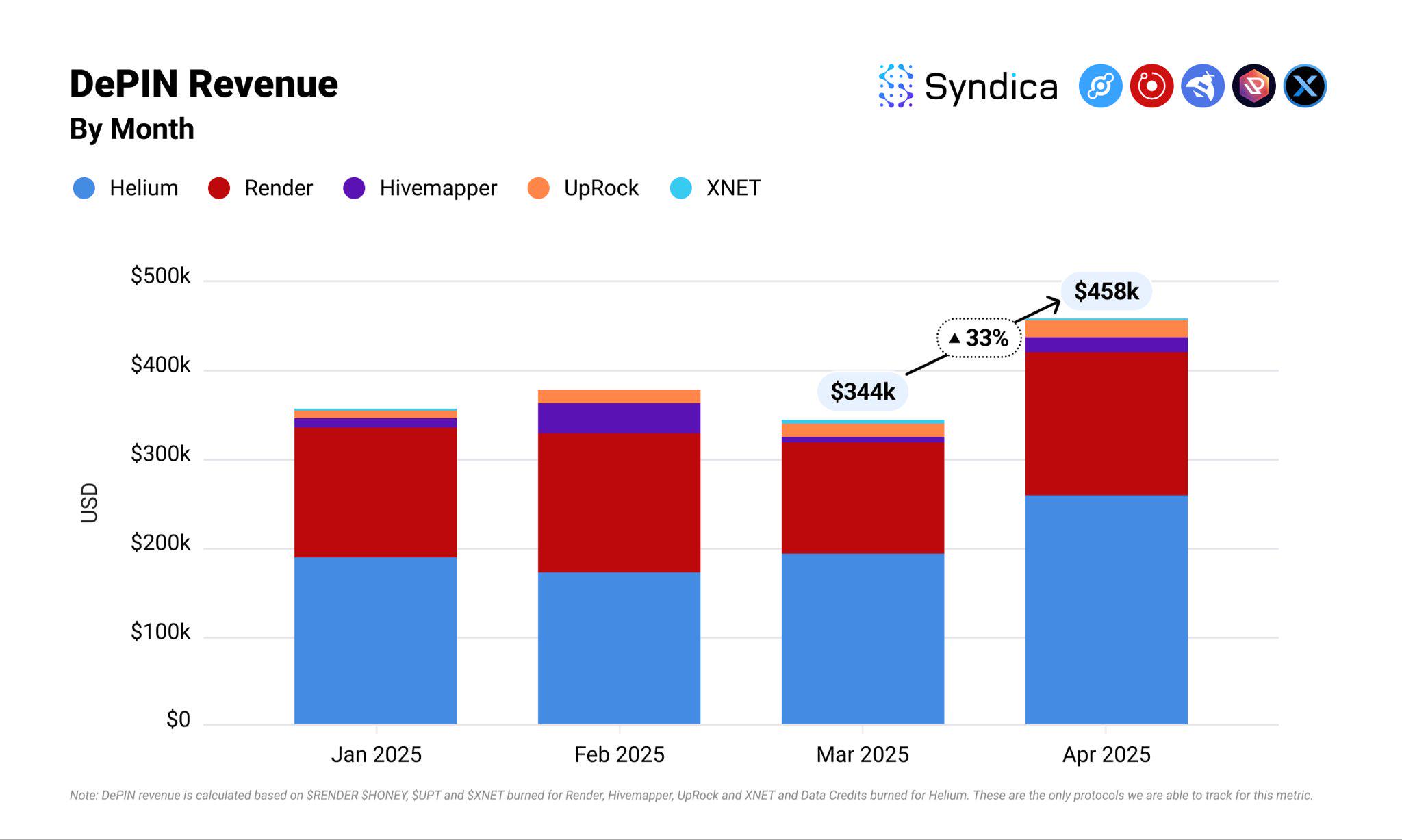
However, the number of active contributors to the DePIN protocol actually fell slightly. Helium, Hivemapper, Nosana, Render, Sallar, Sourceful, and XNET maintained a total of about 87,000 active contributors.
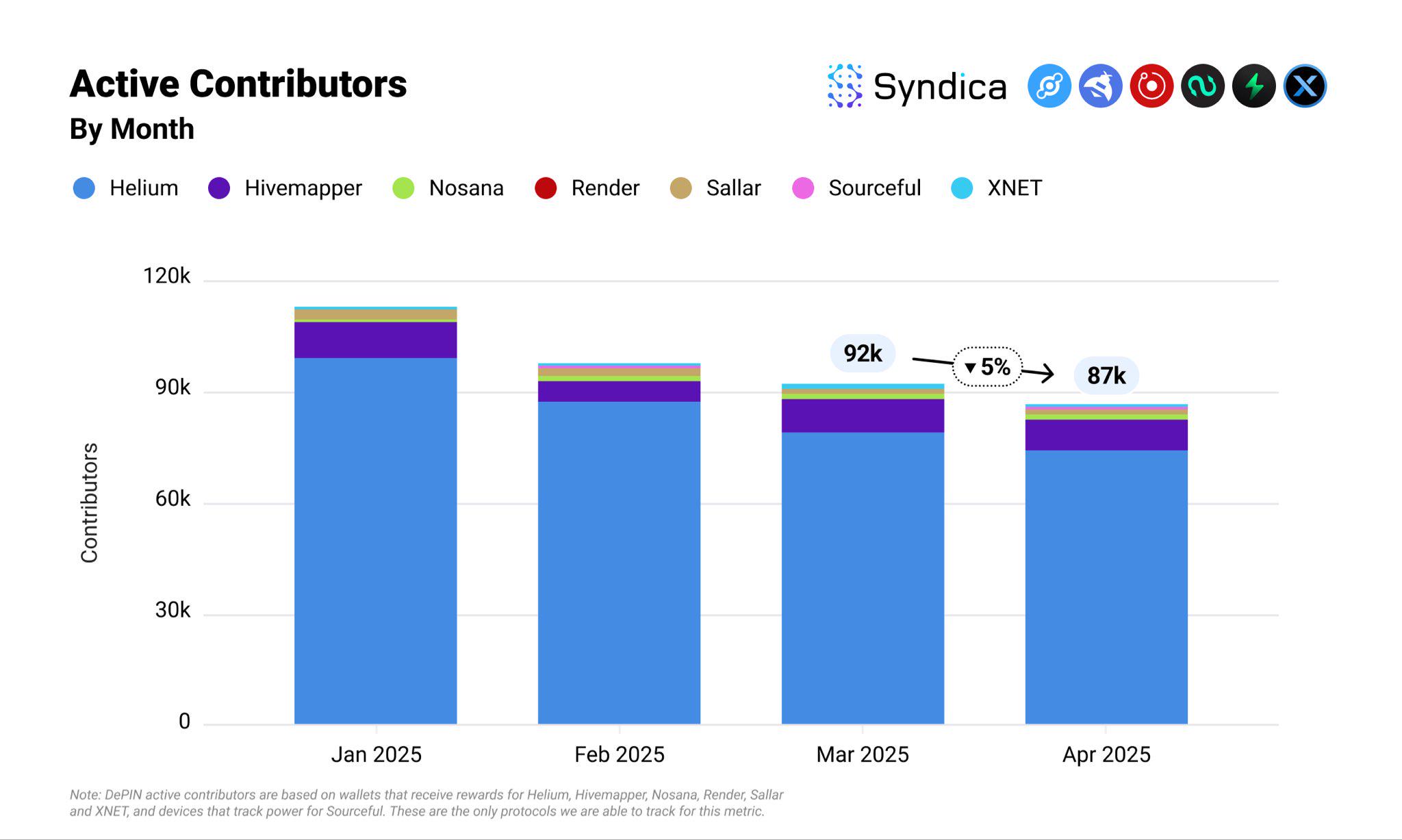
In April 2025, the number of contributors to small DePIN protocols increased significantly, with Nosana growing by more than 100%, while the growth of contributors to large protocols such as Helium and Hivemapper remained flat or slightly declined.
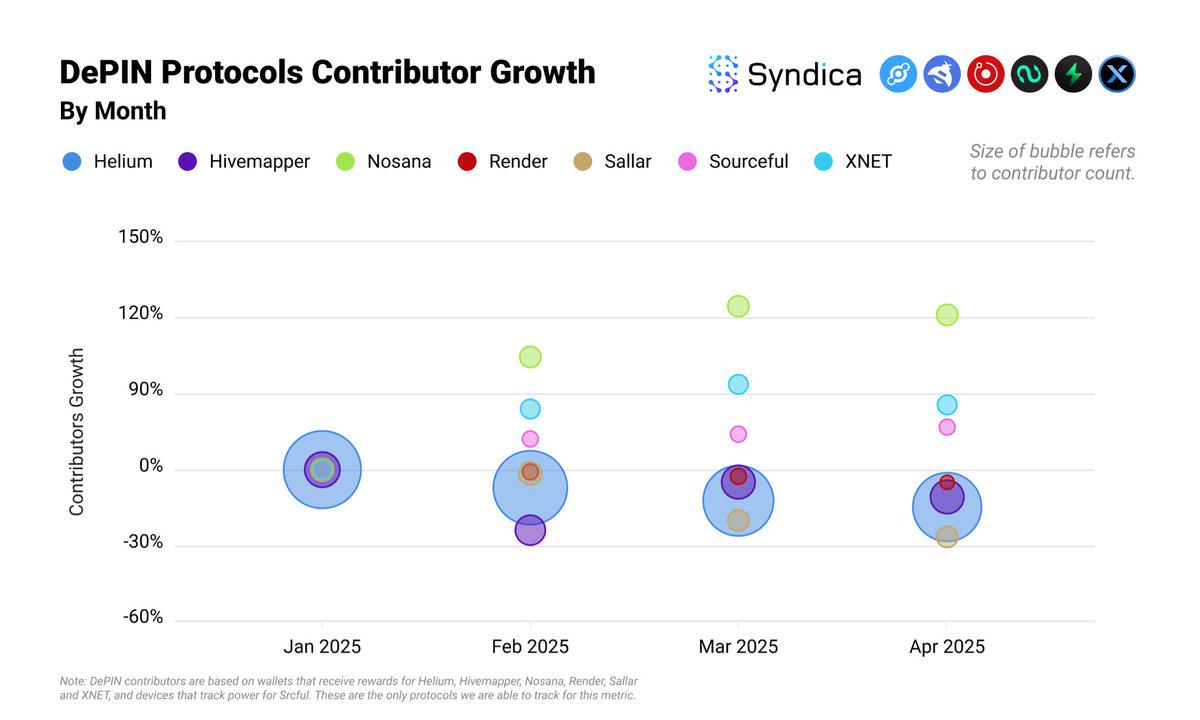
The following is a review of the performance of major DePIN projects:
Dabba Network
Dabba Network is a DePIN exclusively for the Indian market based on Solana. It aims to use the hosted deployment model in cooperation with local cable operators to deploy Wi-Fi hotspots across India and provide users with high-speed, low-cost Internet access services. From March to April, its cumulative data consumption jumped to 8,000 TB, a 2-fold increase; during the same period, equipment sales increased by 29%, further expanding the scale of the network.
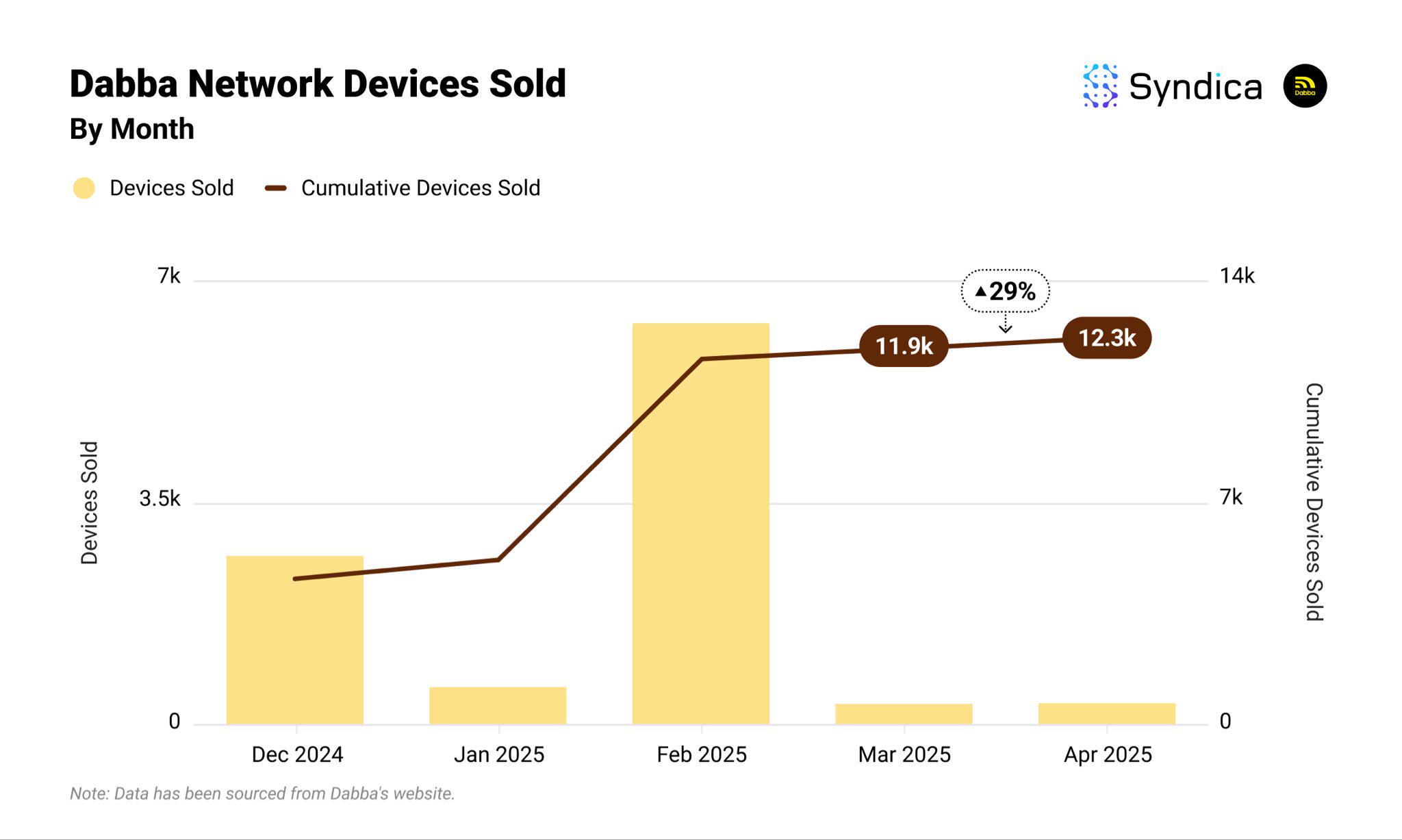
Helium Mobile
Helium Mobile is a mobile virtual network operator under the Helium network, combining community-deployed Wi-Fi hotspots with cellular base stations of partner operators to provide users with low-cost mobile data and voice services.
After Helium Mobile opened its free mobile phone packages to all users, the number of new subscribers surged by 125% to 36,000, a record high. Correspondingly, Helium Mobiles revenue hit a record high of $250,000. The monthly revenue measured by data credit destruction increased by 34% to a new high of $250,000, of which data uninstallation accounted for 79%.
(Note: When users use mobile networks, part of the traffic is offloaded to the hotspot of the Helium network for transmission and billing, and this part of the traffic is called offload data - that is, offload data volume or data offload traffic)
In addition, Helium Mobiles average daily uninstalled subscriptions increased by 65%, and the amount of uninstalled data increased by 32%, both breaking historical records.
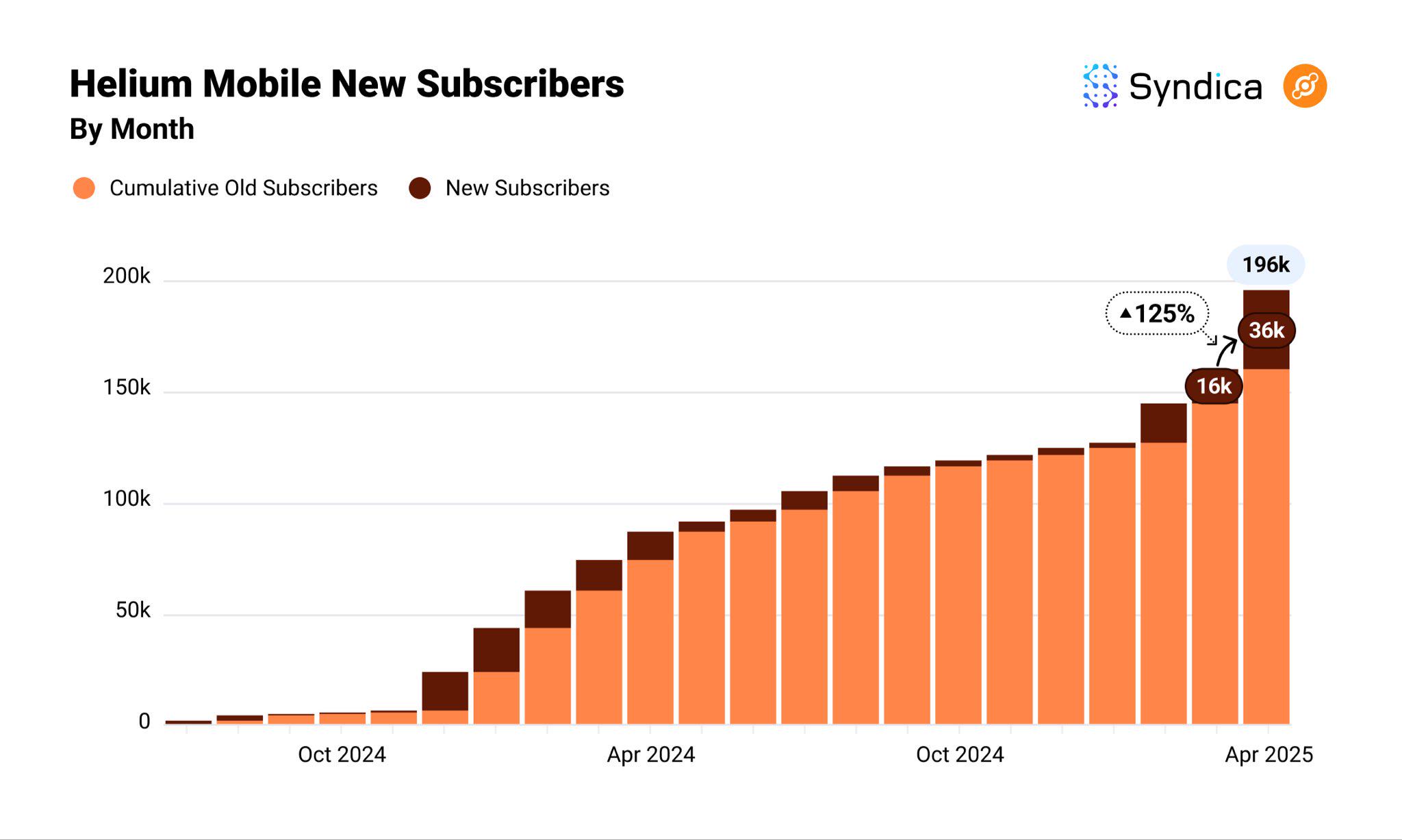
It is worth mentioning that since 2025, the number of active Helium contributors has generally shown a slight downward trend, and the number of active Helium contributors has stabilized at around 75,000.
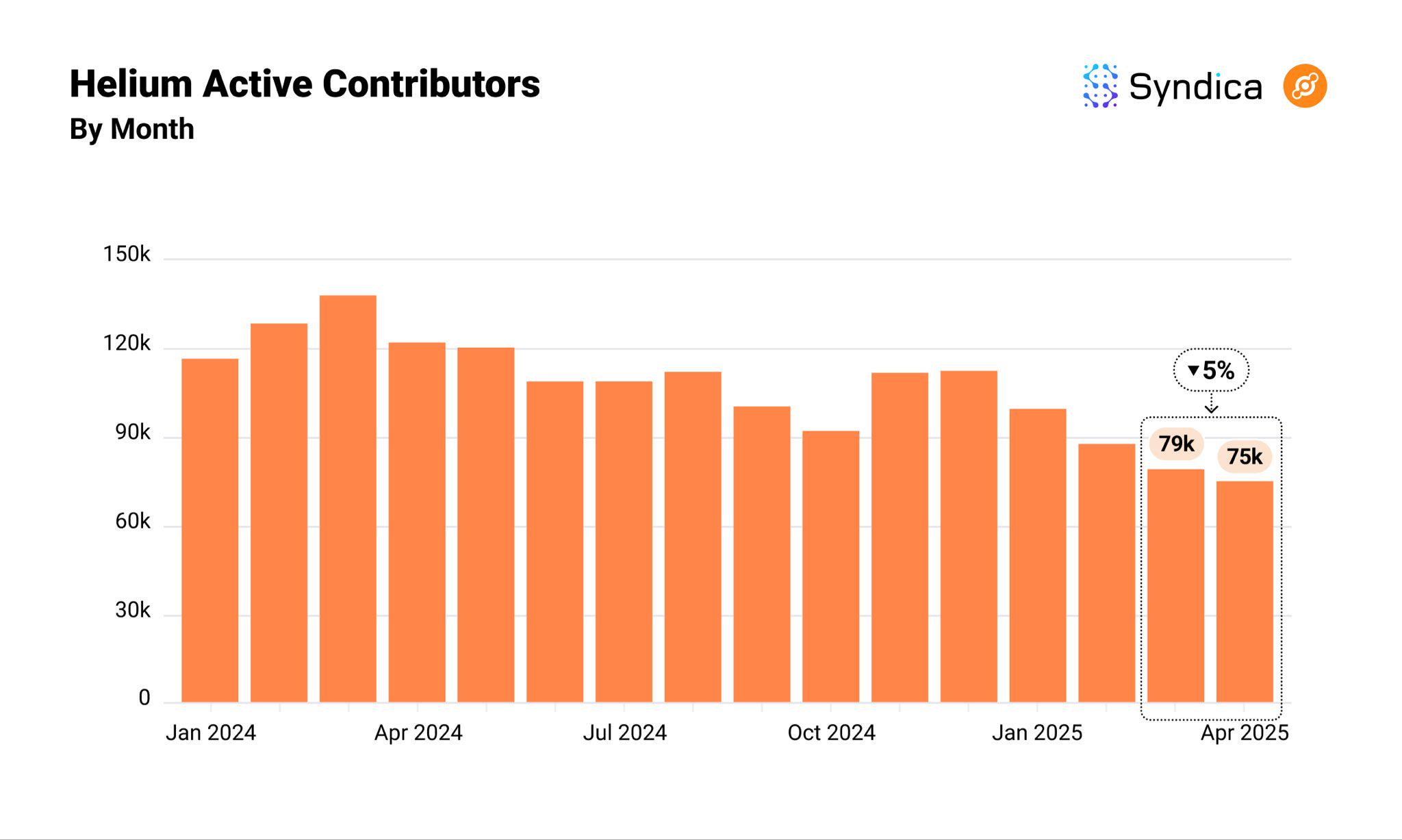
XNET
XNET is a decentralized mobile network built on the Solana blockchain. In April, XNET data offloads continued to grow, with average daily offloads increasing by another 16%, marking an 8-month steady upward trend in XNET data offloads. In addition, despite a 6% drop in rewards, XNET Mobiles active contributors in April still rose by 6% to 732, a record high.
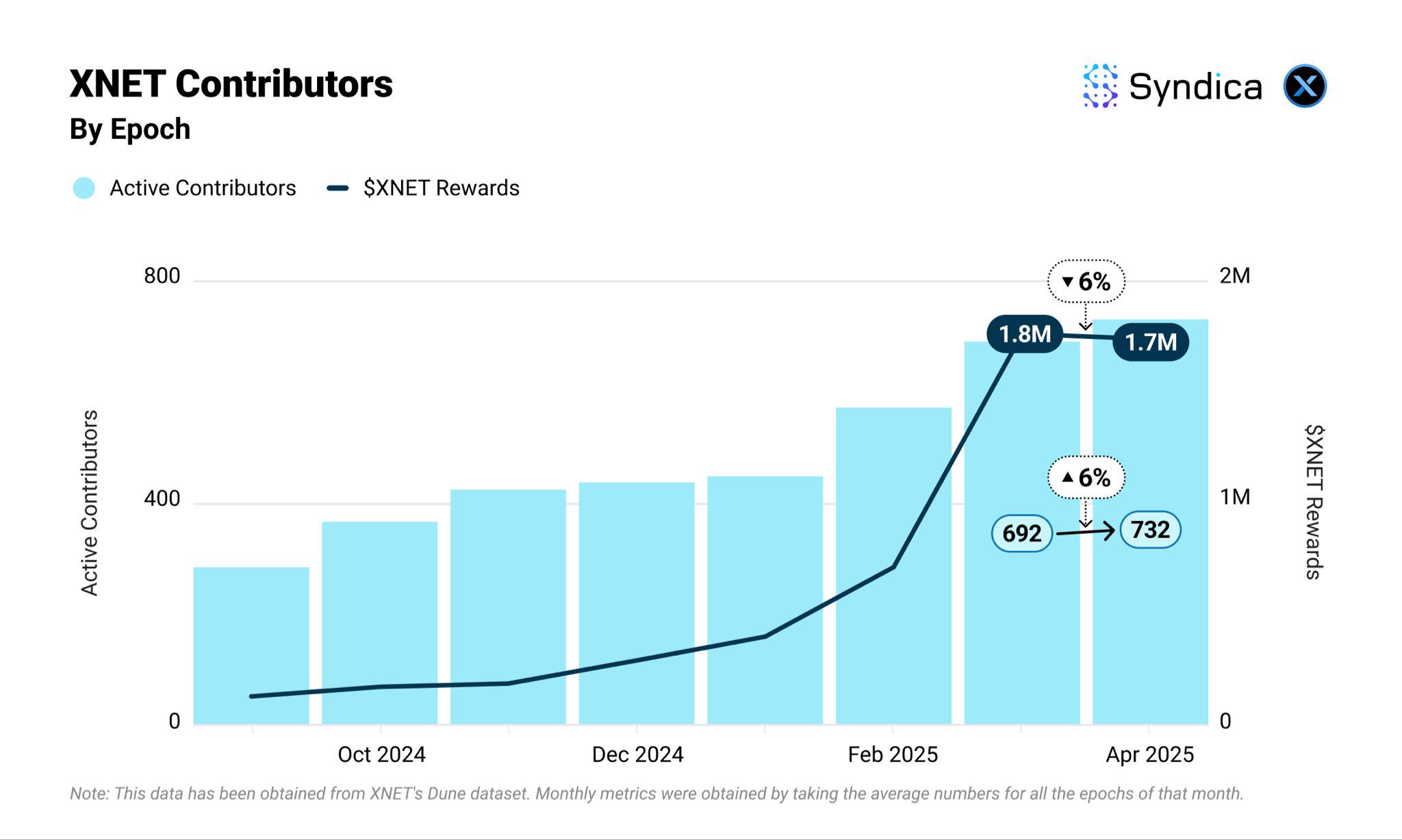
Roam
In April, Roam added 535,000 WiFi nodes (the second highest in history) and 87,000 new users, with the total number of protocol nodes approaching 4 million and the number of users approaching 3 million. Although the monthly user check-in volume decreased by 19%, the cumulative number of check-ins has exceeded 300 million, demonstrating that user stickiness is still strong.
Shaga
The Shaga protocol uses idle GPU computing power to support Web3 games. It currently covers 74 GPU models, provides 33.12 TB of storage and 15.27 Gbps throughput, and has high-performance computing capabilities. Within two months, Shaga achieved 4,500 interactive game live broadcasts with a total duration of 50,000 hours. The audience can control and participate in the hosts game in real time.
Hivello
Hivello is a DePIN aggregation platform used to monetize idle resources. Its online time in April doubled compared to March, and more nodes joined the contribution network.
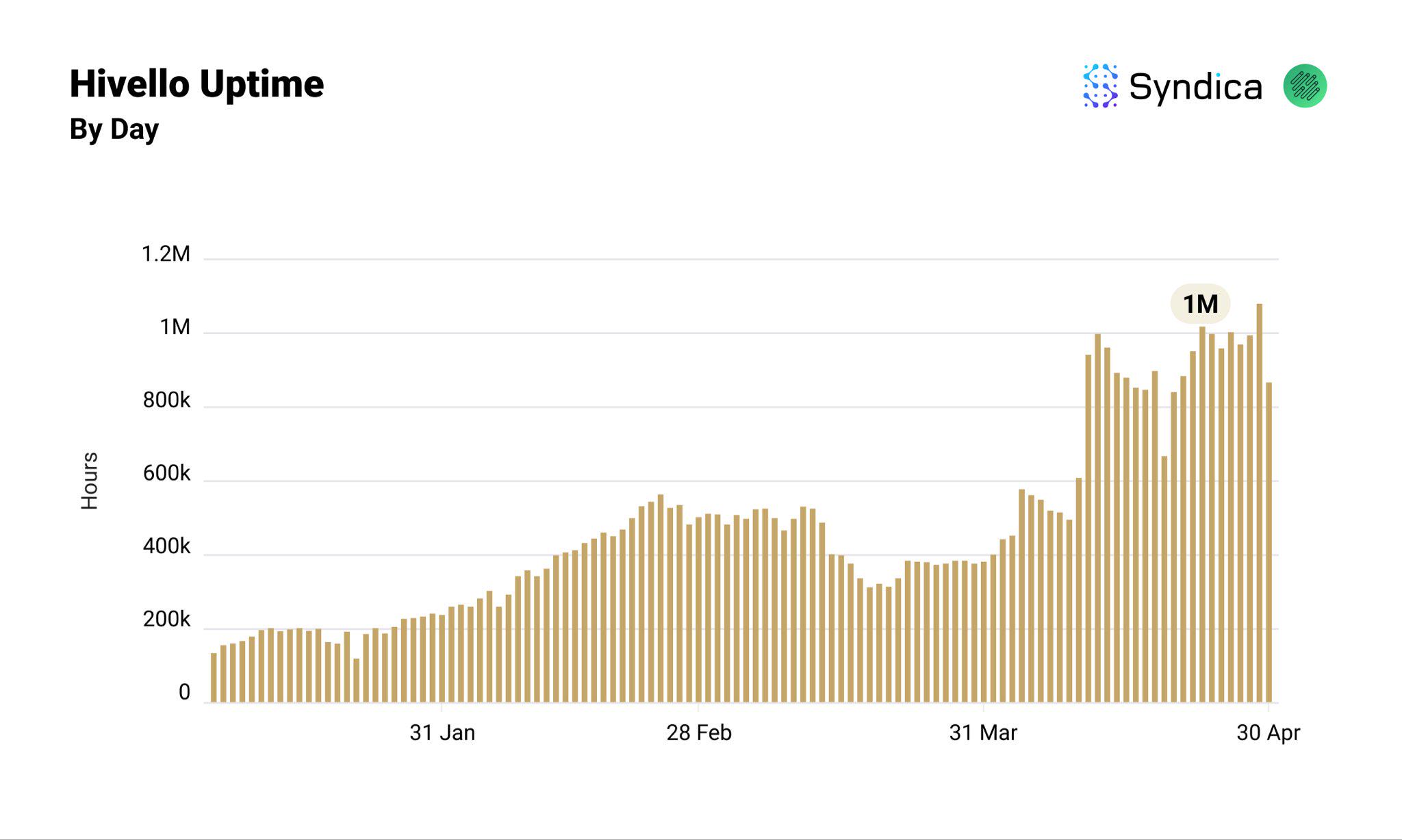
Nosana
Nosana is a decentralized GPU computing network built on the Solana blockchain, focusing on providing a distributed computing power market for AI inference workloads. In April, Nosanas job completion volume (in the Nosana network, whenever an AI client submits an inference request, the network will assign the request to one or more GPU nodes for execution. The entire process of this request from the start of calculation to the return of the result is called a job) and contributor rewards increased slightly, and GPU nodes remained stable; the newly launched Gaianet AI cooperation project allows AI agents to run on Nosana infrastructure, or promote job growth.
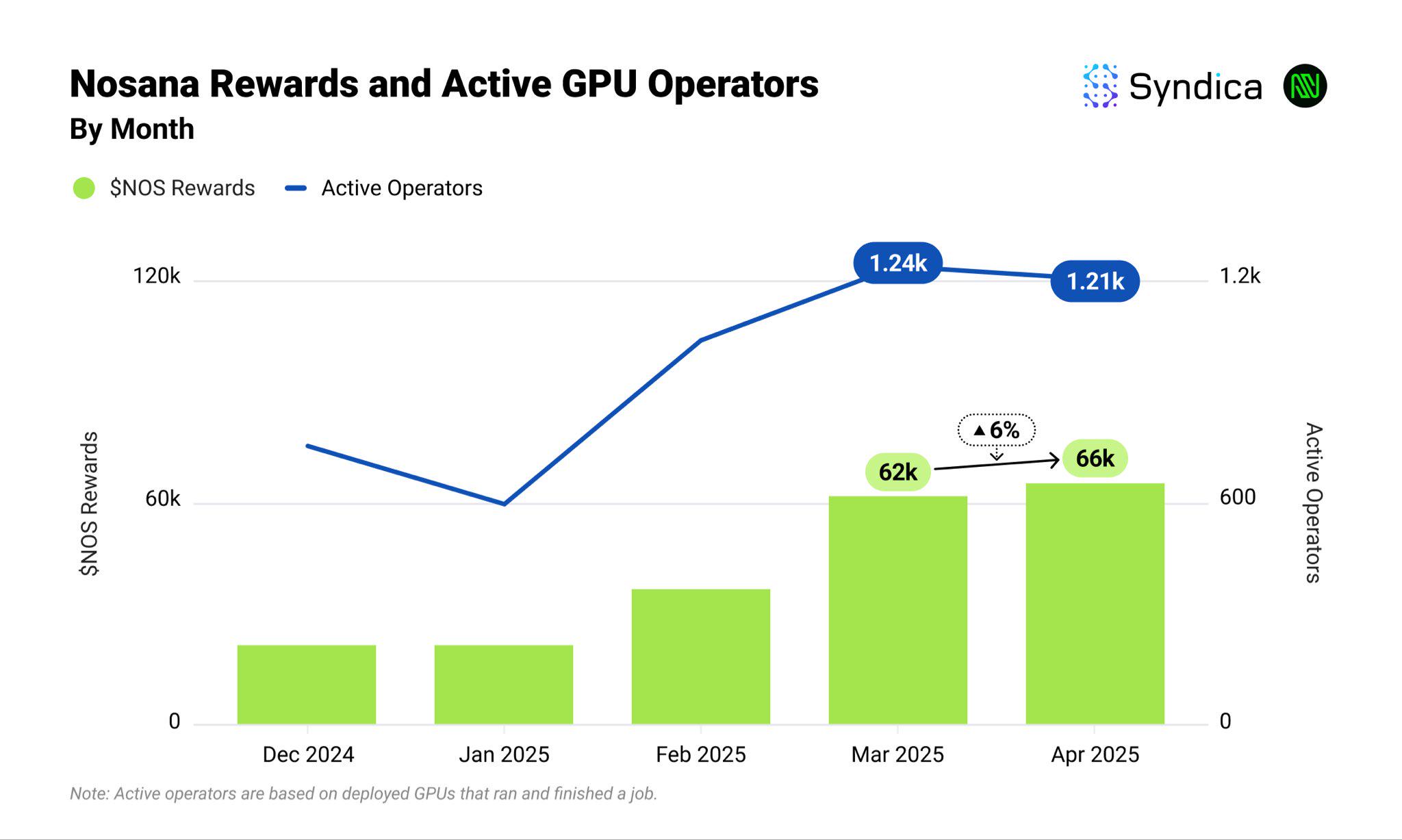
Sallar.io
Sallar is a protocol that connects the idle computing power of devices such as smartphones to the network to form distributed computing nodes to support high-performance computing needs. In April, Sallars US dollar rewards increased by 27% month-on-month. As a protocol for sharing device computing power to complete AI tasks, the US dollar reward increased to US$11,800 in April, and the number of active wallets remained stable.
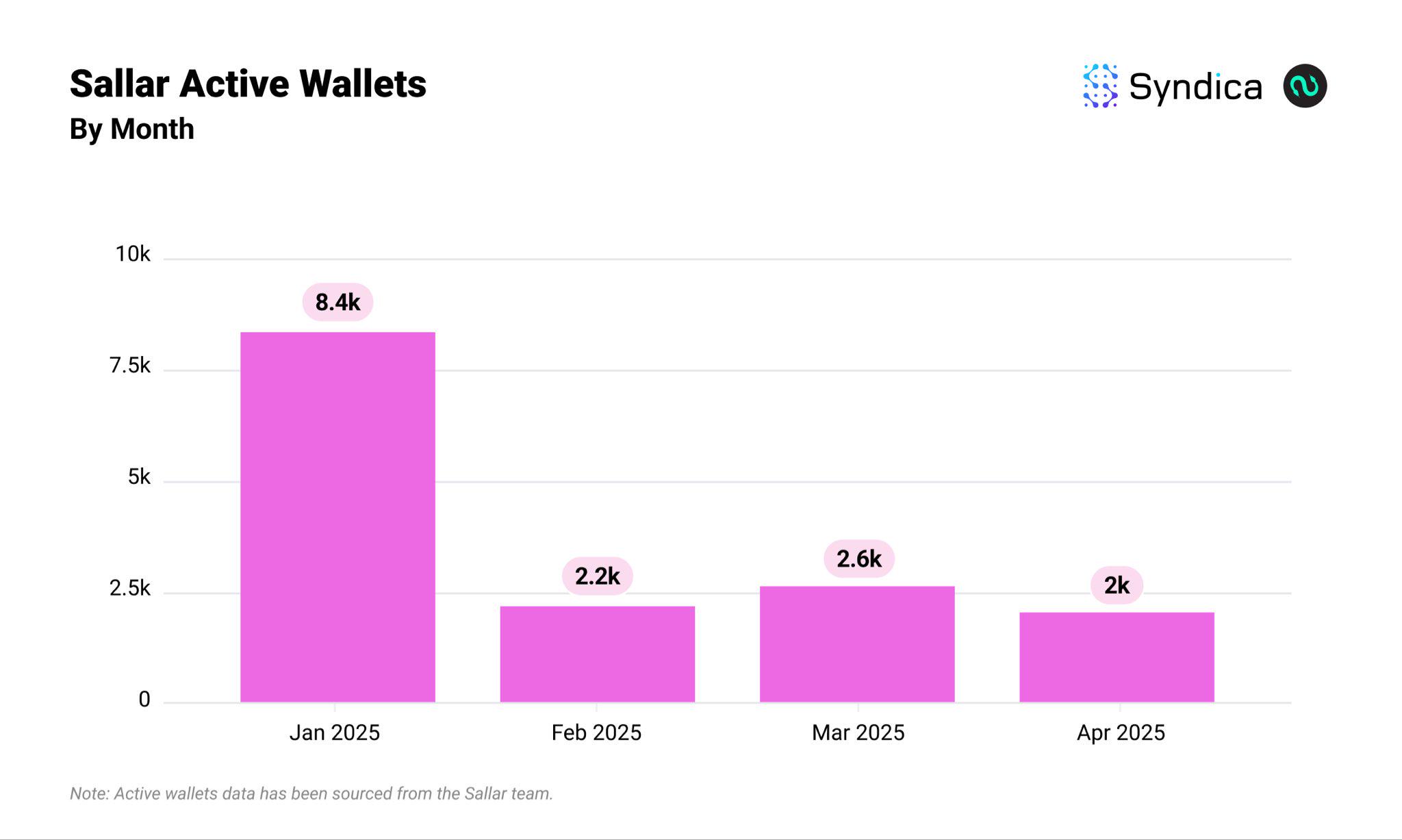
Grass
Grass connects the idle Internet bandwidth of user devices to the network, provides the underlying data source for AI training, data crawling and proxy services, and rewards participants in the form of on-chain tokens. In April, Grass data collection hit a new record high of 34.5 million GB.
Wingbits
Wingbits is a decentralized physical infrastructure network (DePIN) project based on the Solana blockchain. It collects aircraft data such as airplanes, helicopters, and drones in real time through ADS-B hardware deployed by users around the world, and uploads this data to the chain in exchange for native token rewards. Since November 2024, the number of flights tracked by the Wingbits network has increased to 150,000, and the number of data points collected daily has increased to 9 billion, up 7% and 29% respectively; the number of contributing stations has also increased by 43% to 3,000.
Hivemapper
Hivemapper is a decentralized mapping network where users collect street-level images through dashcams and are rewarded with HONEY tokens. The team continues to iterate on the product side, and 20-30% of the monthly Beekeeper platform fees will be used to destroy $HONEY, which may further promote growth.
Hivemappers monthly mapping mileage remained stable in April, and its AI-driven platform Beekeeper for fleet management was officially launched that month, which will bring new growth momentum as more fleets join. Since February, the number of active map contributors to Hivemapper has remained stable at about 5,000.
NATIX Network
NATIX Network aims to collect street view and geographic data through smartphones and dedicated devices to provide high-precision positioning and imaging support for map making, autonomous driving and physical AI. Participants can receive token rewards for data contribution. The ecosystem remained stable in April - user-driven mileage remained at 11 million kilometers for the third consecutive month.
Sourceful Energy
Sourceful Energy is centered around a decentralized virtual power plant (VPP), connecting household and commercial distributed energy resources (such as solar panels, electric vehicles, energy storage batteries, etc.) to the Solana on-chain network. Participants can receive token incentives for contributing electricity or data. In April, Sourceful Energys power output increased by 30%, and with the newly launched Zap smart energy efficiency analysis device receiving 500 pre-orders, the growth trend is expected to continue.
AmbiosNetwork
Ambios Network has built the worlds largest environmental monitoring DePIN. By deploying low-cost air quality and environmental sensors, it provides real-time, hyper-local environmental data to support enterprises, AI and public services. Sensor owners can receive token rewards. In April, Ambios Networks cumulative user ecological data check-in exceeded 2 million times, and the number of ecological data check-ins increased by 12%; the total number of platform users increased to 45,000, a year-on-year increase of 2%.
